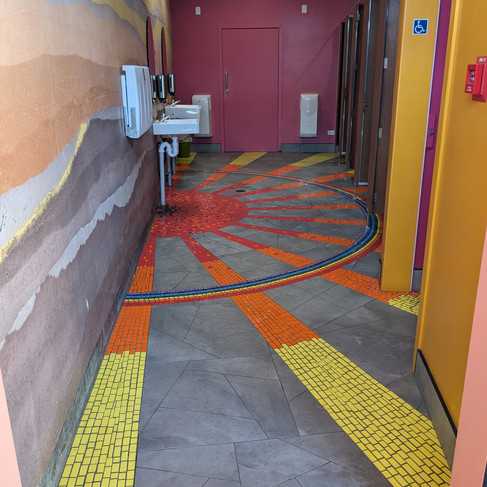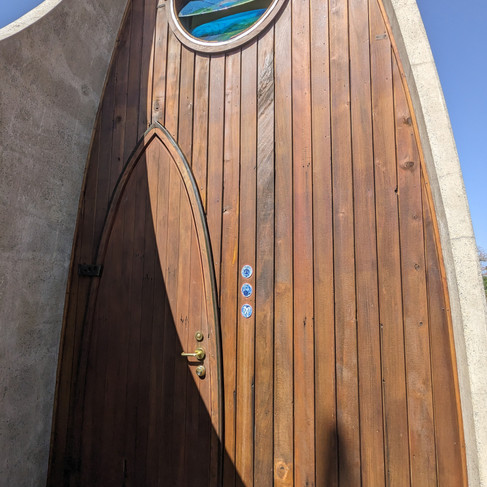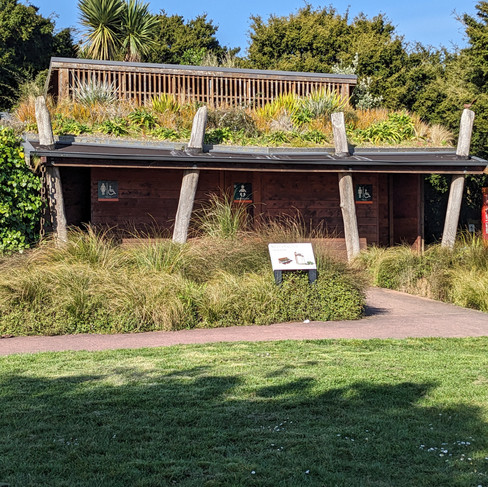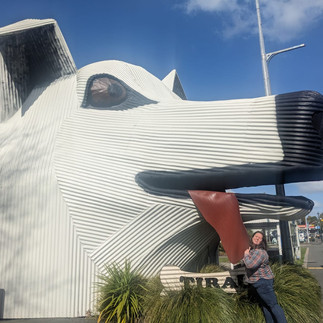Sharing Some Public Toilets in Aotearoa
- Kimberly Worsham
- Sep 24, 2023
- 6 min read
Updated: Jan 24, 2024
FLUSH's Founder recently went on a road trip across Aotearoa/New Zealand (used interchangeably) and got to experience some of the most curious, stunning, and fascinating modern public toilets in the world. Please enjoy this review of a few notable public toilets in the North Island.

Aotearoa's Unique Public Toilets
Aotearoa is one country that can brag about its public toilet situation. The country has a lot of public toilets for its locals and tourists. In a 2021 study, New Zealand was among the top 5 countries with the best access to public toilets. Part of this is to accommodate people living with disabilities, and part of it seems to be a way to celebrate the remarkable and diverse culture and landscapes across the country.
Aotearoa also makes its public toilets something to remember – they have many that are architecturally impressive and have award-winning designs. City councils seemed to realize in the last few decades that beautiful public toilets can boost tourism and have invested money into new facilities. It may also be one of the original places where the idea of Toilet Tourism started to form. A tour book called Kiwi As Toilets: Where to go when you need to go in New Zealand explores dozens of public toilets to visit while driving around. And Kiwis certainly get around to touring their toilets.
Left to right: A toilet in a former movie set, a toilet sign in Queenstown, a public toilet with wild wallpaper in the South Island (Credit: FLUSH/K Worsham)
We visited lots of toilets on this road trip, but we won't look at them all for now. Sure, we could look at the Hobbiton toilet in the Green Dragon Inn; instead, we'll look at six toilets on the North Island that are noteworthy on their own.
Hundertwasser Toilets x 2 (Kawakawa)
Potentially the most famous public toilet in Aotearoa is in the North Island's most northern reaches, in a sleepy town called Kawakawa. Technically, this town has two notable public toilet facilities – we'll discuss both below. Still, the one people hop on buses to visit is an artist's final masterpiece. They're called the Hundertwasser Toilets.
Born in the late 1920s, Fredrich Hundertwasser was an Austrian artist and architect trained at the Academy of Fine Arts in Vienna. He traveled the world creating thought-provoking artwork and buildings across Europe, focusing on opposing straight lines. He first visited New Zealand in the 1970s, fell in love with the country, and moved near Kawakawa to spend the remaining years of his life.
Images of the original Hundertwasser Toilets. Clockwise: Front view, handwashing area, toilet stall, tree (Credit: FLUSH/K Worsham)
In 1998, the Kawakawa Community Board commissioned Hundertwasser to work on building a public facility that tourists would want to use and visit while going to the popular Bay of Islands. At the time, Kawakawa was a former coal town dying in the changing economic environment.
A walk through the Hundertwasser Toilets (Credit: FLUSH/K Worsham)
Hundertwasser's vision was to make an ecologically integrated public space. He used recycled bottles and tiles as well as reused bricks from the area to build the mosaiced walls. When building the toilets, he built them around a living tree and made the rooftop a garden.
The toilets opened in 1999, and Hundertwasser died in 2000. They were his final piece of artwork.
People noticed the strange toilet designs and visited Hundertwasser's final piece. It attracts about 250,000 people a year to the little town, and more people visit the toilet than use them! Recently, the country's government heritage agency listed the public toilets as a Category 1 Historic Place.
The Hundertwasser-inspired toilets. Clockwise: Building's entrance, toilets with showers, toilet exit, toilet stalls (Credit: FLUSH/K Worsham)
In 2020 and 2021, the town council of Kawakawa decided to build an additional public toilet facility to accommodate the growing traffic of camper vans and tourists in the area. Two female artists were commissioned to build additional toilets (and showers) in a new building just behind the original Hundertwasser toilets, including a library and art gallery. The new designs are clearly inspired by the originals and are lovely to look at.
The success of Hundertwasser's toilets in Kawakawa has led to serious consideration and investment of $19.3 million in tourism funding across the country. Some of the following toilets were immediate products of the new government efforts to create noteworthy toilets for visitors.
Matakana Boat Toilets (Matakana)
Matakana's Public Toilet. Clockwise: Outside from street, outside of door, toilet stall, toilet signs (outside) (Credit: FLUSH/K Worsham)
Matakana is an hour south of Kawakawa, where another recent public toilet marvel stands. In the early 2000s, the town struggled to agree on a public toilet for its growing business area. Some wanted colorful toilets, while others wanted more utilitarian toilets (or something else). After seven years of debate and building, the town held a design competition for public toilets. The winner was a young student at Auckland University (Steffan de Haan). The abstract toilet design is based on boat hulls – the town had a boat-building industry – and cost about $400,000.
Botanic Gardens Toilet (Auckland)
Left to right: Auckland Botanic Garden's toilets with live roof and swale, inside hygiene instructions (Credit: FLUSH/K Worsham)
Driving south from Matakana, the country's economic hub of Auckland, can't be left out of the toilet tourism tour. Going into the free access Auckland Botanical Gardens, visitors have access to toilets notable for their environmental focus.
This toilet has a living green roof with native plants! This is a relatively new thing in the country, and the garden's roof is a testing ground for other roofs to look at for future plantings. Living roofs absorb rainwater, which slows down the water speed and reduces the amount of stormwater hitting sewer drains by 65%. The roof's plants also regulate the temperature in the bathrooms, providing a home for animals, plants, and insects.
The roof also lets excess water drain into the swale underneath it. Swales filter the stormwater while slowing it down further before flowing it back into the garden lakes. Roofs and swales aren't always the easiest environment for plants, and the gardens often trial different kinds of hearty native plants to ensure their sustainability.
Big Dog i-SITE (Tirau)
Left to right: Big Dog i-SITE building, other side, public toilet (Credit: FLUSH/K Worsham)
On the drive further south from Auckland, one could stop in a small town called Tirau to look at its corrugated iron building designs. This quirky town characteristic started in the mid-1990s with the development of a building that looks like a big sheep to attract visitors to local farmstands and shops selling handmade knitted and woven goods. It cost $100,000 to build the big sheep.
The success of the big sheep building brought on a second building next to it – the Big Dog Information Center. The building needed to house a public toilet for the growing number of visitors to see the whacky building art, and local artisans worked to create the cartoonish head. The town asked the family owning the property with the big sheep permission to build a public toilet next to it, and they agreed…provided it would complement the sheep's design. The building also houses an i-SITE for tourists to book adventures.
Once Big Dog and Big Sheep were visible on the road in 1998, the rest of the town started to follow suit, building amusing building art with corrugated metal – from flip flops to safari animals and even a sassy bird with heels and pearls. There are other public toilets in the town – with an Outhouse – that people can also use.
Lobster Loos (Wellington)
Lobster Loos in Wellington (Credit: FLUSH/K Worsham)
Another fun and abstract public toilet is in the country's capital – Wellington. The reddish toilets have looming tails that have given them the nickname "lobster loos" because they look like lobster eyes, though some think they look like aardvark noses.
The Lobster Loos opened in 2011, designed by Bret Thurston in a competition from the Studio of Pacific Architecture that the Wellington City Council commissioned. Once again, the council was inspired by Hundertwasser's toilets further north. Their construction cost about $375,000. Since then, they have received laurels for being one of the best toilets. They have been featured by Lonely Planet as one of the most extraordinary toilets in the world (in a book and an article).
Final Thoughts
Left to right: Toilets in Auckland, toilets in Queenstown, other toilets in Queenstown
(Credit: FLUSH/K Worsham)
Maybe this wasn't the case in previous years, but the most remarkable thing about these toilets in Aotearoa was how accessible, reliable, and safe they all were. Finding a humble porta-potty in the most remote areas was not uncommon, and even the quietest towns with little more than a gas station had clean, functioning toilet stalls.
The country takes pride in its original public toilets and wants to keep its people and gorgeous natural settings safe and healthy. It's comforting to be in a country that ensures tourism doesn't stop when bodily functions need to happen, and it's delightful to use toilets that are fun and cheeky.





















































Comments